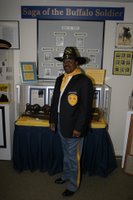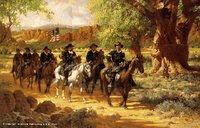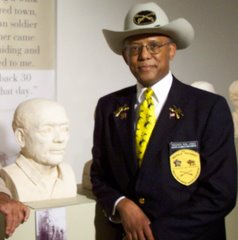
Pictured above, from left to right seated, are: Trooper Robert McDaniel, World War II veteran who served with the 9th Cavalry regiment stationed at Fort Riley and for a time was a member of headquarter staff and worked for Gen. Benjamin O. Davis Sr., Trooper Alfred Evans, WWII veteran who served with the 10th Cavalry regiment, Trooper John Tull, WWII veteran who served with the 10th Cavalry regiment, Trooper Andrew Isaacs, WWII veteran with the 10th Cavalry regiment and is the newly elected President of the L.A. Chapter, Trooper Eugene Lewis, WWII veteran, 28th Cavalry regiment 'C' Troop, stationed at Camp Lockett in California and outgoing L.A. Chapter President, Trooper Andrew Aaron, Korean War veteran and a member of the 24th Infantry regiment.
Second row: Nathaniel Hosea, WWII veteran and a member of the Mondfort Point Marines, Retired U.S. Army Colonel Franklin Henderson, past National President of the 9th & 10th (Horse) Cavalry Association, Trooper Fred Cartha, WWII veteran, served with the 10th Cavalry regiment and is this year's recipient of the Los Angeles Chapter Buffalo Soldier "Trooper of the Year" award, Trooper Phillip Wilkes Fixico, descendant of the Seminole Negro Indian Scouts, Trooper Jean Lewis, US Army veteran of the Cold War era, Trooper Gwen Jones.
The back five: Trooper Charles Allen, Korean War veteran and a member of the 24th Infantry regiment, Trooper Erich Hicks, Vietnam War veteran, Trooper James Cooper, WWII veteran, served in the 24th Infantry regiment and was a driver in Patton's Red Ball Express, Trooper Walter Brady, Iraqi War veteran, Trooper Lennister Williams, Vietnam War veteran and retired Sgt. Maj U.S. Army.
During WWII and the Korean War, the Buffalo Soldier regiments consisted of the 24th and 25th Infantries and the 9th, 10th, 27th and 28th Cavalries. The cavalry regiments made up the 2nd Cavalry Division which was deactivated in 1944. When President Truman's Executive Order 9981 was fully implemented in 1951, bringing an end to segregation in the arm forces, it closed the door on the history that was the Buffalo Soldiers of the segregated U.S. Army. These men represent the last of the original Buffalo Soldiers who served in those segregated regiments.


















